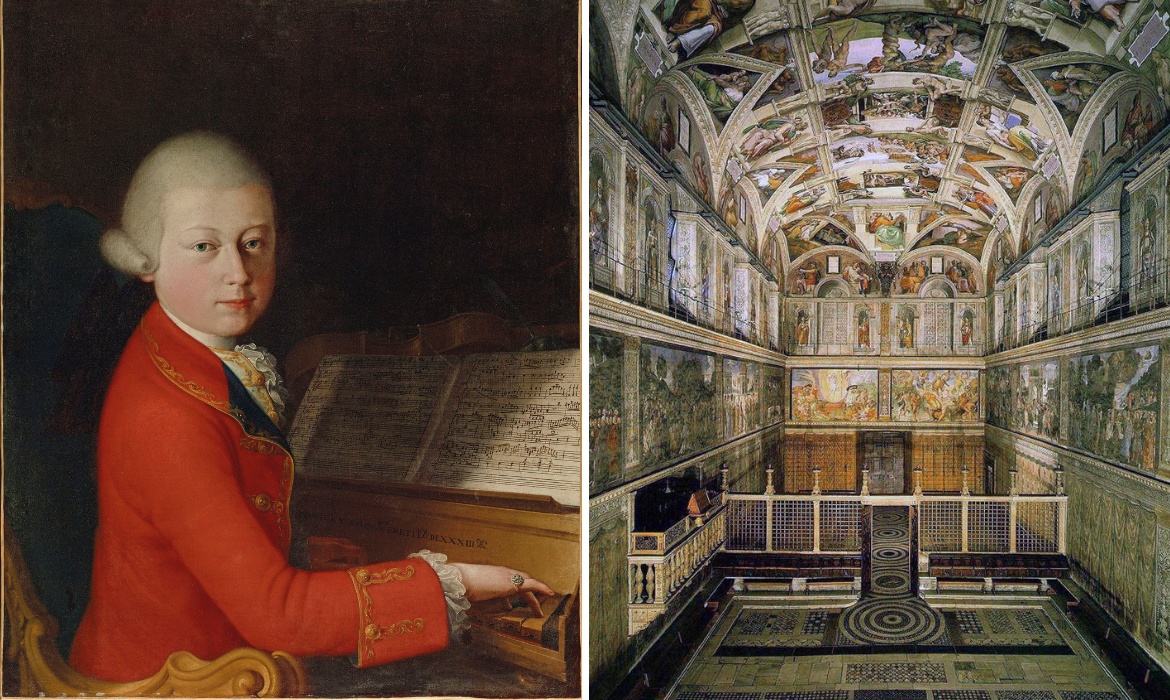
Left: Mozart at age 14 (Photo: attributed to Giambettino Cignaroli via Wikimedia Commons, Public domain) | Right: Interior of the Sistine Chapel (Photo: Snowdog via Wikimedia Commons, CC BY-SA 3.0)
We all know that Mozart was a genius, but did you know that his musical memory helped smuggle a secret song out of the Vatican? Originally composed for Pope Urban VIII during the 1630s, Gregorio Allegri's “Miserere mei, Deus” (“Have mercy on me, Oh God”) was a closely guarded secret. It was only played in the Sistine Chapel during Tenebrae services of Holy Week, and it gained fame for the use of a particular ornamentation that was largely unknown outside the Vatican.
It's said that, to preserve this secrecy, the pope forbade the transcription of the song at the risk of excommunication. Later, rumors circulated that only three transcriptions existed, one for the Holy Roman Emperor, one for the king of Portugal, and one for Mozart's mentor, Padre Martini. A popular story states that when a young 14-year-old Mozart visited Rome in 1770, he went to the Sistine Chapel with his father for Holy Week services and listened to Allegri's song.
Thanks to a letter that his father, Leopold, wrote to his wife, we know what happened next. “You have often heard of the famous Miserere in Rome, which is so greatly prized that the performers in the chapel are forbidden on pain of excommunication to take away a single part of it, to copy it or to give it to anyone. But we have it already. Wolfgang has written it down.”
In a follow-up letter, perhaps to ease his wife's worries, Leopold clarified that “even the Pope knows” that he transcribed it and that there was no cause for concern. While this makes Mozart's transcription the first unauthorized version of the song, there is actually evidence that “Miserere” wasn't completely a secret by this time. Scholars believe there were already authorized copies of the song circulating in Europe, with Mozart possibly even hearing the piece in London several years earlier.
What we do know is that Mozart's version was eventually published in 1771 by British music historian Dr. Charles Burney and that this version does not include the ornamentation the piece was known for. The piece is still performed today, but what we currently hear is not the same as Allegri's original version, and not even the same as what was performed before 1900, according to author Graham O'Reilly. Today's version combines aspects of later transcriptions and includes the difficult “top C” note that was not in the original. Even with these changes, Allegri's “Miserere” remains a popular a cappella choral work with a fascinating past.
Listen to “Miserere mei, Deus” performed by the King's College Choir in Cambridge, England.
Source: ‘Allegri's Miserere' in the Sistine Chapel; Gregorio Allegri’s Miserere mei
Related Articles:
8 Facts About the Classical Music Composer Ludwig van Beethoven
200 Years After Chopin’s Death, New Enchanting Waltz Is Discovered
Researchers Discover Previously Unknown Music Mozart Composed as a Teenager
What Mozart’s Music Actually Sounds Like When Played on His Original Pianoforte






















































































